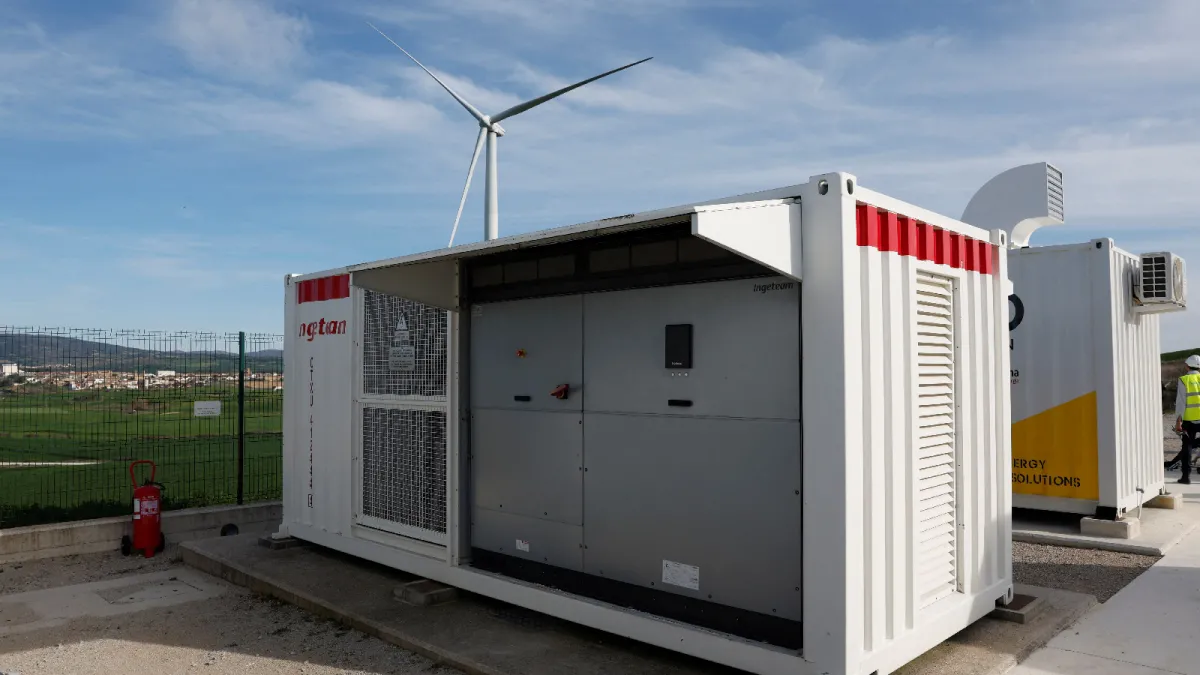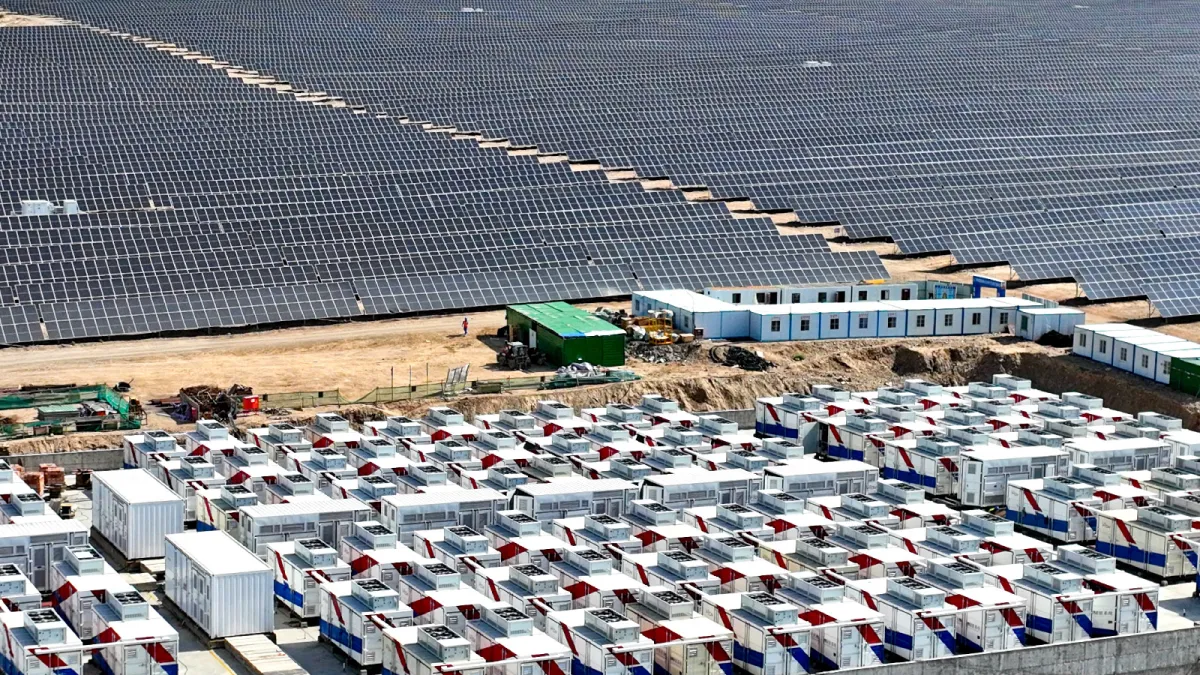Why Energy Storage is Essential for a Green Transition
Learn how energy storage can provide reliable renewable energy.
On a beautiful day in May 2022, California accomplished something remarkable. The wind was strong, the sun was beaming, and the state generated enough renewable electricity to meet 103 percent of consumer demand for several hours.
Yet, even as that historic record was broken, fossil fuel power plants were still running in California that day.
Why couldn’t the state shut down fossil fuel plants if renewables were producing more than enough energy? Well, eventually, the sun sets and the wind dies down. But people will still need electricity, so grid operators continue to rely on fossil fuel plants.
So how can humans fully phase out fossil fuels if major renewable sources of energy do not always provide enough energy when they need it? The answer could be storing renewable energy during sunny and windy times and then using that emission-free energy later.
This learning resource will discuss why energy storage is an essential part of transitioning to renewable energy, how the process works, and what challenges and opportunities exist for the future.
Why countries need energy storage
The amount of electricity the energy grid produces should always be in balance with the amount consumers use. Any imbalance, whether there’s too much or too little power, can lead to blackouts and damage equipment. So, grid operators predict how much electricity will be used over the course of a day and make plans to produce that amount of electricity in advance. Then they follow through on their plan but adjust how much electricity is produced in real time to match how demand deviates from their predictions.
In the past, that process was relatively straightforward. Grid operators largely controlled how much electricity each power source supplied to the grid. To balance the grid, they would monitor how much demand changed in order to determine the amount of supply. Nowadays, though, grid operators don’t have as much control over their power sources, so they need to adjust power production to match changes in demand and supply. That is due to the rise in renewable energy sources.
Wind and solar energy are what experts call intermittent energy sources. They depend on natural factors like sunlight, wind speed, and weather conditions. Energy output from solar and wind farms can therefore fluctuate depending on the time of day, the season, and the location.
Another challenge is that wind and solar energy are not dispatchable, meaning they cannot be adjusted on demand. Many fossil fuel power plants can be ramped up or down relatively quickly by burning more or less fuel. But people can’t make the wind blow harder or the sun shine more brightly.
Energy storage offers a solution. Capturing and storing excess renewable energy when it is plentiful and releasing it as needed could solve both problems. On sunny and windy days, renewable energy sources can supply energy storage systems, which can be deployed at night, on cloudy days, or when there’s less wind.
Energy storage systems offer several other benefits, too. For one, they can make power grids more flexible. In times of low demand, excess electricity generated in power plants can be routed to energy storage systems. When demand rises—during a heat wave, for example—stored energy can be deployed to avoid straining the grid. Stored energy can also provide backup power. If an outage affects a power plant, stored energy can take over to keep communities powered while the plant is repaired.
To meet global climate targets, renewable energy will need to produce nearly 90 percent of the world's electricity by 2050. But as California has shown, transitioning to renewables isn’t just about producing more clean energy. Energy storage will play an essential role in the green transition too.
How to store energy
Some large-scale storage technologies are already in use today, and scientists are racing to discover new techniques that can save power for longer and more affordably. Let’s take a closer look at some energy storage systems.
Pumped Hydropower
Like traditional hydropower, pumped hydropower uses flowing water to spin turbines and generate electricity. The difference is that, during periods of surplus energy, a pumped hydropower station uses electricity to pump water back to a reservoir at the top of the system. Then, grid operators can release water from the reservoir to generate electricity as needed.
Pumped hydropower is the most widely used energy storage technique today, accounting for more than 90 percent of the world's energy storage. Countries are continuing to invest in pumped hydropower systems, especially China, which is on track to more than double its capacity by 2030. Still, growth has slowed in recent years relative to other emerging technologies. That is in part because pumped hydropower comes with several challenges. Droughts, for instance, can compromise hydropower stations and cause electricity shortages. And pumped hydropower systems can have high upfront costs, long construction times, and pose environmental risks. Additionally, finding suitable locations where water can flow between elevations can be challenging.
Batteries
Just like phones and electric vehicles, very large batteries can store power for the grid. Batteries are one of the most flexible energy storage options. They can be employed quickly to respond to changing demand. And they can be scaled up or down to work in many different places: relatively small batteries can power individual homes, while arrays of massive batteries can supply entire grids. That flexibility has quickly made batteries incredibly popular. Currently, they are the fastest growing storage method worldwide. U.S. battery storage capacity grew tenfold between 2021 and 2024 and is expected to keep growing.
Lithium-ion batteries—the same kind used in phones and electric vehicles— are the most common battery used for large-scale energy storage. They are popular because they can store a lot of energy and don't need much maintenance. But current technology has drawbacks. Batteries can only store energy for a few hours. And shortages of critical minerals like lithium keep prices high. Batteries also pose an environmental risk; making them can generate hazardous waste, and if they catch fire, they can emit toxic chemicals. Batteries also degrade over time. Current lithium-ion batteries have a lifespan of about ten to fifteen years, after which they will need to be recycled or disposed of. Still, despite those challenges, new research is improving battery technology quickly and can help bring costs down.
Mechanical Energy Storage
Together, pumped hydropower and batteries make up roughly 98 percent of global energy storage capacity. But other technologies are functioning around the world as well. Some systems use electricity to compress air at up to one thousand pounds per square inch and store it, often in underground caverns. Others use electricity to spin a large flywheel at up to sixty thousand revolutions per minute. When needed, the rotational force of the flywheel can be used to power a generator. Like pumped hydropower, those systems are both mechanical, meaning they rely on converting between kinetic and potential energy.
Compressed air and flywheels can pose fewer environmental risks than batteries and pumped hydropower, and they have long lifespans and require less maintenance. However, if those systems fail, they can cause significant damage. And like batteries, mechanical systems have relatively short discharge times.
Thermal Energy Storage
Some energy storage systems take advantage of thermal energy, using sunlight or electricity to heat materials like water, mineral oil, metals, or molten salts. Once stored, that thermal energy can be redeployed to heat homes during the winter or power turbines to generate electricity.
Thermal systems require little maintenance and last a long time—some plants can store months’ worth of energy. And they pose fewer environmental risks than other options. Although they cannot generate electricity as efficiently as other systems, thermal storage systems are an excellent source of heat for buildings or industrial processes. This has made them increasingly attractive for developers. Between 2020 and 2030, for example, the total market for thermal energy storage is expected to more than double in value.
The Future of Energy Storage
Energy storage plays a crucial role in adding high levels of renewable energy to the grid and reducing the demand for electricity from inefficient, polluting power plants. The good news is that energy storage strategies are being adopted rapidly. The global energy storage market almost tripled in size in 2023, and analysts expect it to keep growing at an annual rate of 21 percent through 2030. Some experts worry, however, that even that robust progress is not enough. The record-breaking additions in 2023 totalled 45 gigawatts (GW). That’s enough to power roughly thirty-seven million homes. To get on track with global climate targets, the world will need to add 1,500 GW of energy storage capacity to its grids by 2030.
Still, the pace of energy storage development is accelerating, and new innovations are emerging that can make the process cheaper, more flexible, and more efficient. Systems that use electricity to produce clean hydrogen, for example, can offer high-efficiency, cost-effective storage options for the future. Those new innovations, combined with improvements on proven methods like pumped hydropower, will play a vital role in making energy grids greener.







